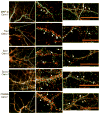The neuronal Arf GAP centaurin alpha1 modulates dendritic differentiation
- PMID: 17635995
- PMCID: PMC2810648
- DOI: 10.1242/jcs.006346
The neuronal Arf GAP centaurin alpha1 modulates dendritic differentiation
Abstract
Centaurin alpha1 is an Arf GTPase-activating protein (GAP) that is highly expressed in the nervous system. In the current study, we show that endogenous centaurin alpha1 protein is localized in the synaptosome fraction, with peak expression in early postnatal development. In cultured dissociated hippocampal neurons, centaurin alpha1 localizes to dendrites, dendritic spines and the postsynaptic region. siRNA-mediated knockdown of centaurin alpha1 levels or overexpression of a GAP-inactive mutant of centaurin alpha1 leads to inhibition of dendritic branching, dendritic filopodia and spine-like protrusions in dissociated hippocampal neurons. Overexpression of wild-type centaurin alpha1 in cultured hippocampal neurons in early development enhances dendritic branching, and increases dendritic filopodia and lamellipodia. Both filopodia and lamellipodia have been implicated in dendritic branching and spine formation. Following synaptogenesis in cultured neurons, wild-type centaurin alpha1 expression increases dendritic filopodia and spine-like protrusions. Expression of a GAP-inactive mutant diminishes spine density in CA1 pyramidal neurons within cultured organotypic hippocampal slice cultures. These data support the conclusion that centaurin alpha1 functions through GAP-dependent Arf regulation of dendritic branching and spines that underlie normal dendritic differentiation and development.
Figures








Similar articles
-
ADAP1/Centaurin-α1 Negatively Regulates Dendritic Spine Function and Memory Formation in the Hippocampus.eNeuro. 2021 Jan 6;8(1):ENEURO.0111-20.2020. doi: 10.1523/ENEURO.0111-20.2020. Print 2021 Jan-Feb. eNeuro. 2021. PMID: 33139322 Free PMC article.
-
Drebrin-dependent actin clustering in dendritic filopodia governs synaptic targeting of postsynaptic density-95 and dendritic spine morphogenesis.J Neurosci. 2003 Jul 23;23(16):6586-95. doi: 10.1523/JNEUROSCI.23-16-06586.2003. J Neurosci. 2003. PMID: 12878700 Free PMC article.
-
Identification of centaurin-alpha1 as a potential in vivo phosphatidylinositol 3,4,5-trisphosphate-binding protein that is functionally homologous to the yeast ADP-ribosylation factor (ARF) GTPase-activating protein, Gcs1.Biochem J. 1999 Jun 1;340 ( Pt 2)(Pt 2):359-63. Biochem J. 1999. PMID: 10333475 Free PMC article.
-
Functions of the neuron-specific protein ADAP1 (centaurin-α1) in neuronal differentiation and neurodegenerative diseases, with an overview of structural and biochemical properties of ADAP1.Biol Chem. 2014 Nov 1;395(11):1321-40. doi: 10.1515/hsz-2014-0107. Biol Chem. 2014. PMID: 24854535 Review.
-
Centaurin-alpha1 and KIF13B kinesin motor protein interaction in ARF6 signalling.Biochem Soc Trans. 2005 Dec;33(Pt 6):1279-81. doi: 10.1042/BST0331279. Biochem Soc Trans. 2005. PMID: 16246098 Review.
Cited by
-
PQBP1, a factor linked to intellectual disability, affects alternative splicing associated with neurite outgrowth.Genes Dev. 2013 Mar 15;27(6):615-26. doi: 10.1101/gad.212308.112. Genes Dev. 2013. PMID: 23512658 Free PMC article.
-
ADAP1 limits neonatal cardiomyocyte hypertrophy by reducing integrin cell surface expression.Sci Rep. 2018 Sep 11;8(1):13605. doi: 10.1038/s41598-018-31784-w. Sci Rep. 2018. PMID: 30206251 Free PMC article.
-
The epilepsy and intellectual disability-associated protein TBC1D24 regulates the maintenance of excitatory synapses and animal behaviors.PLoS Genet. 2020 Jan 31;16(1):e1008587. doi: 10.1371/journal.pgen.1008587. eCollection 2020 Jan. PLoS Genet. 2020. PMID: 32004315 Free PMC article.
-
Cdk5 Is Essential for Amphetamine to Increase Dendritic Spine Density in Hippocampal Pyramidal Neurons.Front Cell Neurosci. 2017 Nov 24;11:372. doi: 10.3389/fncel.2017.00372. eCollection 2017. Front Cell Neurosci. 2017. PMID: 29225566 Free PMC article.
-
Neurodevelopmental Impairment As the Main Phenotypic Hallmark Associated with the Translocation t(7;10)(7p22.3;q26.11).J Pediatr Genet. 2020 Aug 20;11(1):68-73. doi: 10.1055/s-0040-1715479. eCollection 2022 Mar. J Pediatr Genet. 2020. PMID: 35186394 Free PMC article.
References
-
- Aggensteiner M, Reiser G. Expression of the brain-specific membrane adapter protein p42IP4/centaurin a, a Ins(1,3,4,5)P4/PtdIns(3,4,5)P3 binding protein, in developing rat brain. Brain Res Dev Brain Res. 2003;142:77–87. - PubMed
Publication types
MeSH terms
Substances
Grants and funding
LinkOut - more resources
Full Text Sources
Molecular Biology Databases
Miscellaneous

